
Saw it last night, just as the sky was turning dark about 9 PM in Las Vegas. In the NW sky below the big dipper. Spotted it with low power binoculars, soon after could see it with the naked eye. Not the most spectacular comet I've ever seen, but maybe worth a look see for those interested.
The head of the comet is only about 3 miles across, but seems much larger (considering it's 65 million miles away), due to it giving off dust and gas, which is pushed by the solar wind to form the tail.
If you miss it, the next chance to see it will be in about 7020.
Great post pj.
Great picture. Those are ideal conditions in that bone dry desert air and amazing visibility.
We are surrounded by trees and I may try to drive out a bit this evening to try to catch a glimpse.
I have a huge telescope. If it looks impressive tonight, I might take the grand kids out tomorrow night and try to use the telescope.
https://www.space.com/comet-neowise-slooh-webcast.html
It will get higher and higher in the sky for the next several days.

This chart shows the appearance of Comet NEOWISE on the evenings of July 14 –23. | Courtesy Sky & Telescope
The observation was a big bust for me but not a surprise.
Clear skies but way too much humidity and haze especially above the horizon to a height of where the comet is located.
Our humidity was 70% with a visibility of just 10 miles vs the Las Vegas humidity of 11% and visibility unlimited.
I drove out in the sticks and parked with harvested Winter wheat field between me and the horizon...........so no trees or man made structures in the way.
Glad I didn't take the grandkids and spoil their enthusiasm but this is a good reminder to try to make astronomy part of their learning.
Haven't gotten out the telescope for them in years but we've observed Jupiter and, I think 3 of the 4 moons before.
https://earthsky.org/astronomy-essentials/how-to-see-jupiters-moons
Posted by Deborah Byrd and Paul Scott Anderson in Astronomy Essentials | July 12, 2020
Jupiter is now at its best time of the year for viewing, so turn your binoculars or telescope on the giant planet for a glimpse of its 4 largest Galilean moons.
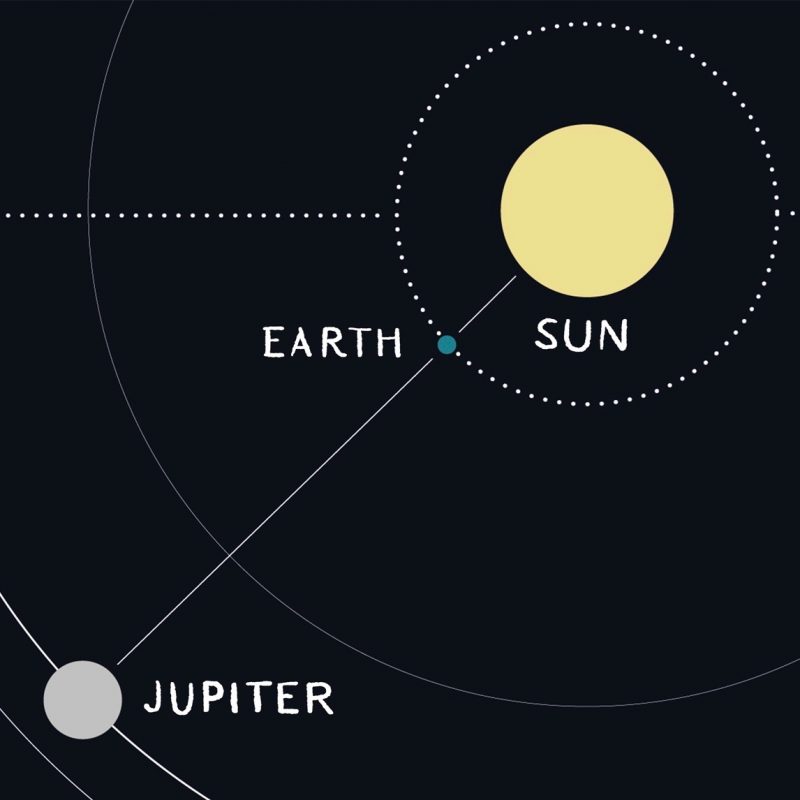
On July 13-14, 2020, Jupiter is at opposition, when Earth passes directly between Jupiter and the sun. Opposition is the middle of the best time of the year to see a planet, since that’s when the planet is up and viewable all night and is generally closest for the year. This year, Jupiter is at peak opposition from July 13-14, 2020.
Going from closest moon to Jupiter to the outermost, their order is Io, Europa, Ganymede and Callisto.

https://earthsky.org/astronomy-essentials/visible-planets-tonight-mars-jupiter-venus-saturn-mercury
What do we mean by bright planet? By bright planet, we mean any solar system planet that is easily visible without an optical aid and that has been watched by our ancestors since time immemorial. In their outward order from the sun, the five bright planets are Mercury, Venus, Mars, Jupiter and Saturn. These planets actually do appear bright in our sky. They are typically as bright as – or brighter than – the brightest stars. Plus, these relatively nearby worlds tend to shine with a steadier light than the distant, twinkling stars. You can spot them, and come to know them as faithful friends, if you try.
"Around the world, Jupiter and nearby Saturn rise during nightfall in early July, around sunset in mid-July, and before sundown by the month’s end. You can spot both Jupiter and Saturn easily in July 2020. Look first for brilliant Jupiter; Saturn is the bright object immediately to Jupiter’s east. Although Saturn is easily as bright as a 1st-magnitude star – as bright as the brightest stars in our sky – the ringed planet can’t compete with the the king planet Jupiter, which outshines Saturn by some 15 times.
After all, Jupiter ranks as the fourth brightest celestial object, after the sun, moon, and the planet Venus, respectively.
Jupiter and Saturn are having a great conjunction in 2020. Astronomers use the word conjunction to describe meetings of planets and other objects on our sky’s dome. They use the term great conjunction to describe a meeting of very bright Jupiter and golden Saturn. The last great Jupiter-Saturn conjunction was May 28, 2000. The next one will be December 21, 2020. But July 2020 – when both worlds reach opposition – is the time to start watching these worlds."
mm: "I have a huge telescope."
What type... likely a reflector? How big a mirror?
When I was kid a friend of my father's helped me build 4 1/2" refractor. Was good for the (4) moons of Jupiter, the rings and a couple moons of Saturn. How things have changed, since I was a kid. The latest count is 79 moons for Jupiter and 82 for Saturn.
IMO half way decent binoculars is all you need for the comet, unless, of course, your haze continues to be too thick, in which case nothing will work.
I’ll have to check on the telescope.
Binoculars didn’t work. Not even close. You are not familiar with how bad the haze and low visibility is here when dew points get above 70 in stagnant air.
It’s like this for a good part of summer here.
This reminded me of why I associate some great star gazing with freezing my arse off.
My wife and I would always go on vacation during the first 2 weeks in August during the perseid meteor showers.
Some wonderful views from n,MN or n.ME or n.MI and even Canada, where the air was dry and visibity great as well as being distant from cities.
Funny thing on the telescope. I got it for my oldest sons 8th birthday. It was the biggest one I could find in the area.
An 8 year old would never be able to use it on their own, so I was the one always doing everything from the get go. None of the kids ever got into it. My wife probably got more excited in those days.
So it ended up being dads present.
In looking at our weather, we are not going to have a change of air masses this week to bring in the drier, cleaner high visibilities needed to see anything. We
The comet will be climbing higher in the sy though, so if we can get some drier air in here within a week, it might still be visible.
The reason the haze and fisibility are always worse as you get closer to the horizon is that you are looking thru a longer segment of atmosphere to see what’s above it, the closer you get to the horizon.
It’s actually the same reason that sunsets can feature a red sky.....from Raleigh scattering of visible light which affects the shorter blues much more(causes the blue sky) thru the longer segment/distance the light travels before it reaches your eyes.
What happens near the horizon is that most of the blues/short wave lengths get scattered out from tracking thru so much atmosphere.....leaving the reds, which were already there to be more dominant for eyes that see whatever color dominates.
I’ll post more on that later for others even though I’m sure you know it......but will be the most interested in discussing it....and adding great comments.
COMET NEOWISE UPDATE: We have some good news and some bad news. Bad news first: Comet NEOWISE is beginning to dim. Since it flew by the sun in early July, the comet's brightness has dropped by about 2 magnitudes. Good news: The comet's tail is still visible to the naked eye, and a short exposure with an off-the-shelf camera is sufficient to reveal NEOWISE's magnificence. To wit, this picture taken last night by Jeff Dai from Ankang, China:
Great picture cutworm!
I remember the day that I learned the mathematical equations at the University of Michigan which represented the physical processes which cause the sky to be blue.
The reason being, it was the first time that years of math actually had a real world application that I could connect so strongly with.
Rayleigh scattering applies to the case when the scattering particle is very small (x ≪ 1, with a particle size < 1 /10 wavelength[4]) and the whole surface re-radiates with the same phase. Because the particles are randomly positioned, the scattered light arrives at a particular point with a random collection of phases; it is incoherent and the resulting intensity is just the sum of the squares of the amplitudes from each particle and therefore proportional to the inverse fourth power of the wavelength and the sixth power of its size.[3][5] In detail, the intensity I of light scattered by any one of the small spheres of diameter d and refractive index n from a beam of unpolarized light of wavelength λ and intensity I0 is given by
where R is the distance to the particle and θ is the scattering angle. Averaging this over all angles gives the Rayleigh scattering cross-section[7]
The fraction of light scattered by a group of scattering particles is the number of particles per unit volume N times the cross-section. For example, the major constituent of the atmosphere, nitrogen, has a Rayleigh cross section of 5.1×10−31 m2 at a wavelength of 532 nm (green light).[9] This means that at atmospheric pressure, where there are about 2×1025 molecules per cubic meter, about a fraction 10−5 of the light will be scattered for every meter of travel.
The strong wavelength dependence of the scattering (~λ−4) means that shorter (blue) wavelengths are scattered more strongly than longer (red) wavelengths.
Find the answer in English next (-:
The sky is blue for 3 main reasons.
1. White light from the sun enters the atmosphere with all colors in the visible light spectrum.
2. The size of the particles in our atmosphere, mainly Nitrogen are just the right size, so that they break up the different wave lengths in that white light and scatter them out separately in the sky. Much, much more of the shorter wave lengths are scattered than the longer ones. Blue is a short wave length, red is the longest in the visible spectrum.
3. The human eye is only capable of seeing light/electromagnetic radiation in the visible spectrum..............thats why its called the visible spectrum! We can't see ultraviolet light or microwaves for instance. The human eye can only see the color in the visible spectrum that is being scattered the most(is dominant) even when other colors are being scattered but not as much. Since there is much more blue being scattered, that's the only color that we see in the sky.
Thanks. The link doesn't seem to work.
And the sky tends to look reddish around sunrise and sunset, due to more red light being scattered by passing through a greater distance of smoke, dust and haze?
Thanks much pj, that link is no good anymore.
I will add something else though, to replace it.
A clear cloudless day-time sky is blue because molecules in the air scatter blue light from the sun more than they scatter red light. When we look towards the sun at sunset, we see red and orange colours because the blue light has been scattered out and away from the line of sight.
The white light from the sun is a mixture of all colours of the rainbow. This was demonstrated by Isaac Newton, who used a prism to separate the different colours and so form a spectrum. The colours of light are distinguished by their different wavelengths. The visible part of the spectrum ranges from red light with a wavelength of about 720 nm, to violet with a wavelength of about 380 nm, with orange, yellow, green, blue and indigo between. The three different types of colour receptors in the retina of the human eye respond most strongly to red, green and blue wavelengths, giving us our colour vision.
If shorter wavelengths are scattered most strongly, then there is a puzzle as to why the sky does not appear violet, the colour with the shortest visible wavelength. The spectrum of light emission from the sun is not constant at all wavelengths, and additionally is absorbed by the high atmosphere, so there is less violet in the light. Our eyes are also less sensitive to violet. That's part of the answer; yet a rainbow shows that there remains a significant amount of visible light coloured indigo and violet beyond the blue. The rest of the answer to this puzzle lies in the way our vision works. We have three types of colour receptors, or cones, in our retina. They are called red, blue and green because they respond most strongly to light at those wavelengths. As they are stimulated in different proportions, our visual system constructs the colours we see.

Response curves for the three types of cone in the human eye
When we look up at the sky, the red cones respond to the small amount of scattered red light, but also less strongly to orange and yellow wavelengths. The green cones respond to yellow and the more strongly scattered green and green-blue wavelengths. The blue cones are stimulated by colours near blue wavelengths, which are very strongly scattered. If there were no indigo and violet in the spectrum, the sky would appear blue with a slight green tinge. But the most strongly scattered indigo and violet wavelengths stimulate the red cones slightly as well as the blue, which is why these colours appear blue with an added red tinge. The net effect is that the red and green cones are stimulated about equally by the light from the sky, while the blue is stimulated more strongly. This combination accounts for the pale sky blue colour. It may not be a coincidence that our vision is adjusted to see the sky as a pure hue. We have evolved to fit in with our environment; and the ability to separate natural colours most clearly is probably a survival advantage.
"And the sky tends to look reddish around sunrise and sunset, due to more red light being scattered by passing through a greater distance of smoke, dust and haze?"
Actually, it's because of more blue light being scattered out along the longer path pj. By the time the light reaches an observers eyes, much of the blue is scattered out and the remaining reds can now become dominant enough for our eyes to only sees the reds that are left.
Not just particulate matter in the lower levels but volcanic eruptions that spew tons on SO2-aerosols, and ash have the same effect which can last for more than a year in MAJOR eruptions.
Here's a picture from your old stomping grounds(could have been taken anywhere) after Pinatubo.
https://www.atoptics.co.uk/atoptics/sunvolc.htm
|
https://www.scienceimage.csiro.au/tag/sunset/i/605/sunset-after-mt-pinatubo-eruption-in-1991/

A glorious sunset produced by volcanic ash blasted into the atmosphere by the eruption of Mt Pinatubo in the Philippines in 1991.
Photographer : Atmospheric Research
Funny, how when searching for information to learn and present here, I often run across stuff I had no idea existed.
 The fourth (and final) CD of the 2003 sessions:Mount Pinatubo Sunsets
The fourth (and final) CD of the 2003 sessions:Mount Pinatubo Sunsets
https://en.wikipedia.org/wiki/Jugalbandi
A jugalbandi or jugalbandhi (Kannada: ಜುಗಲ್ಬಂದಿ, Devanagari: जुगलबंदी, Urdu: جگلبندئ, Bengali: যুগলবন্ধী) is a performance in Indian classical music, especially in Hindustani classical music, but also in Carnatic that features a duet of two solo musicians.[1][2] The word jugalbandi means, literally, "entwined twins." The duet can be either vocal or instrumental.
Often, the musicians will play different instruments, as for example the famous duets between sitarist Ravi Shankar and sarod player Ali Akbar Khan, who played the format since the 1940s. More rarely, the musicians (either vocalists or instrumentalists) may be from different traditions (i.e. Carnatic and Hindustani). What defines jugalbandi is that the two soloists be on an equal footing. A performance can only truly be deemed a jugalbandi, if both musicians are neither sole soloist nor solely accompanying. In jugalbandi, both musicians act as lead players, and a playful competition exists between the two performers.
https://www.youtube.com/watch?v=koPQHgJDMhs
https://www.youtube.com/watch?v=00dadPtnWZI
https://www.youtube.com/watch?v=_WLwoQSIKv4
https://www.youtube.com/watch?v=hQFMEiLEbCs
metmike: None of these performances made my top hits list but its always fascinating to see a piece of unique human culture from other places.
Maybe this will help me better prepare for the upcoming cultural revolution (-:
OK, even the best of this type of music, though interesting is not my style.
https://www.youtube.com/watch?v=uGcdSoK595o
However, who remembers the Beatles going to India and picking up a few tips?
Group photo, February 1968. Seated in front of the Maharishi are (front row, from left to right): Ringo Starr, Maureen Starkey, Jane Asher, Paul McCartney, George Harrison, Pattie Boyd, Cynthia Lennon, John Lennon.
"According to Lennon, he wrote some of the "most miserable"[125] and some of his "best" songs while he was in Rishikesh.[126][102] Starr completed his first solo composition, "Don't Pass Me By", which he had begun writing in 1963.[127] In his 2005 autobiography, Donovan recalls that while the other three Beatles played acoustic guitars, Starr sometimes played a set of tabla hand drums, which Harrison had bought for him in Delhi.[128] The retreat was also a productive one for Donovan as a songwriter.[129] He recalls having "many a great little jam" with McCartney and says that, with Harrison demonstrating on sitar the knowledge he had gained through his teacher, Ravi Shankar, he and Harrison were "soon chording a new song or two", including the Indian-styled "Hurdy Gurdy Man".
Wow, this ends up having huge relevance in my life as Donovan's Hurdy Gurdy man has always been one of my favorites, entirely because of the unique instrumentals.
Now I know for the first time, where some of the unique instrumentals came from!
https://www.youtube.com/watch?v=AkSaxvk57mQ
https://en.wikipedia.org/wiki/Hurdy_Gurdy_Man
"Hurdy Gurdy Man" is a song by the Scottish singer-songwriter Donovan. It was recorded in April 1968 and released the following month as a single. The song gave its name to the album The Hurdy Gurdy Man, which was released in October of that year in the United States. The single reached number 5 on the Billboard Hot 100 in the US and number 4 on the UK Singles Chart.[5]
Donovan wrote "Hurdy Gurdy Man" while in Rishikesh in India, where he was studying Transcendental Meditation with the Beatles.[6] The recording features a harder rock sound than Donovan's usual material, supplying a range of distorted guitars and aggressive drums. It also features an Indian influence with the use of a tambura, a gift to Donovan from George Harrison, who also helped write the lyrics. The song may have been influenced by "Green Circles", a psychedelic 1967 song by Small Faces. The similarity is in the melody of the descending verse, the strange vocal delivery, and the topic of being visited by an enlightened stranger. In 2012, Donovan revealed that he had become friends with Small Faces in 1965.[7]
According to some sources, the song was written for the band Hurdy Gurdy (which included Donovan's old friend and guitar mentor Mac MacLeod[8][9] with Donovan intending to be the producer, but the collaboration was cancelled due to creative disagreements, leading Donovan to record the song himself.[10] In the chapter dedicated to the song in Donovan's autobiography, he says that he originally wanted it to be recorded by Jimi Hendrix.[6]
https://en.wikipedia.org/wiki/Hurdy-gurdy
The hurdy-gurdy is a stringed instrument that produces sound by a hand crank-turned, rosined wheel rubbing against the strings. The wheel functions much like a violin bow, and single notes played on the instrument sound similar to those of a violin. Melodies are played on a keyboard that presses tangents—small wedges, typically made of wood—against one or more of the strings to change their pitch. Like most other acoustic stringed instruments, it has a sound board and hollow cavity to make the vibration of the strings audible.
Most hurdy-gurdies have multiple drone strings, which give a constant pitch accompaniment to the melody, resulting in a sound similar to that of bagpipes. For this reason, the hurdy-gurdy is often used interchangeably or along with bagpipes, particularly in Occitan, Catalan, Cajun French and contemporary Asturian, Cantabric, Galician, Hungarian and Slavic folk music.
And to think that this started with your post about the comet!!!
mm:"Here's a picture from your old stomping grounds(could have been taken anywhere) after Pinatubo."
Some red ones from our deck in Seattle. Boy, do I still miss that view... :-(
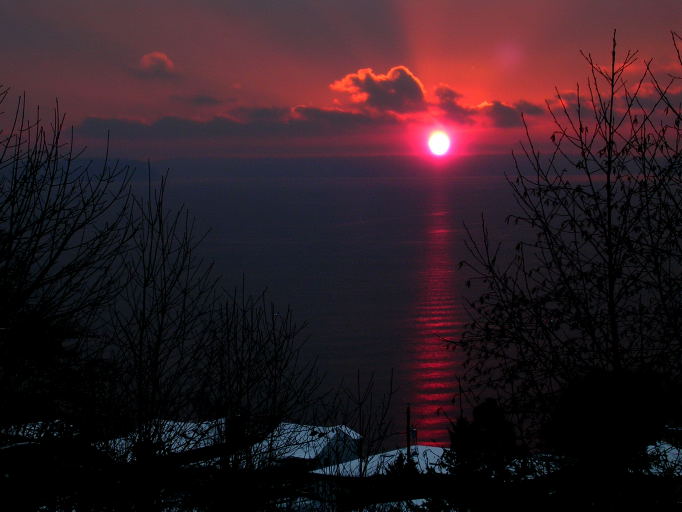
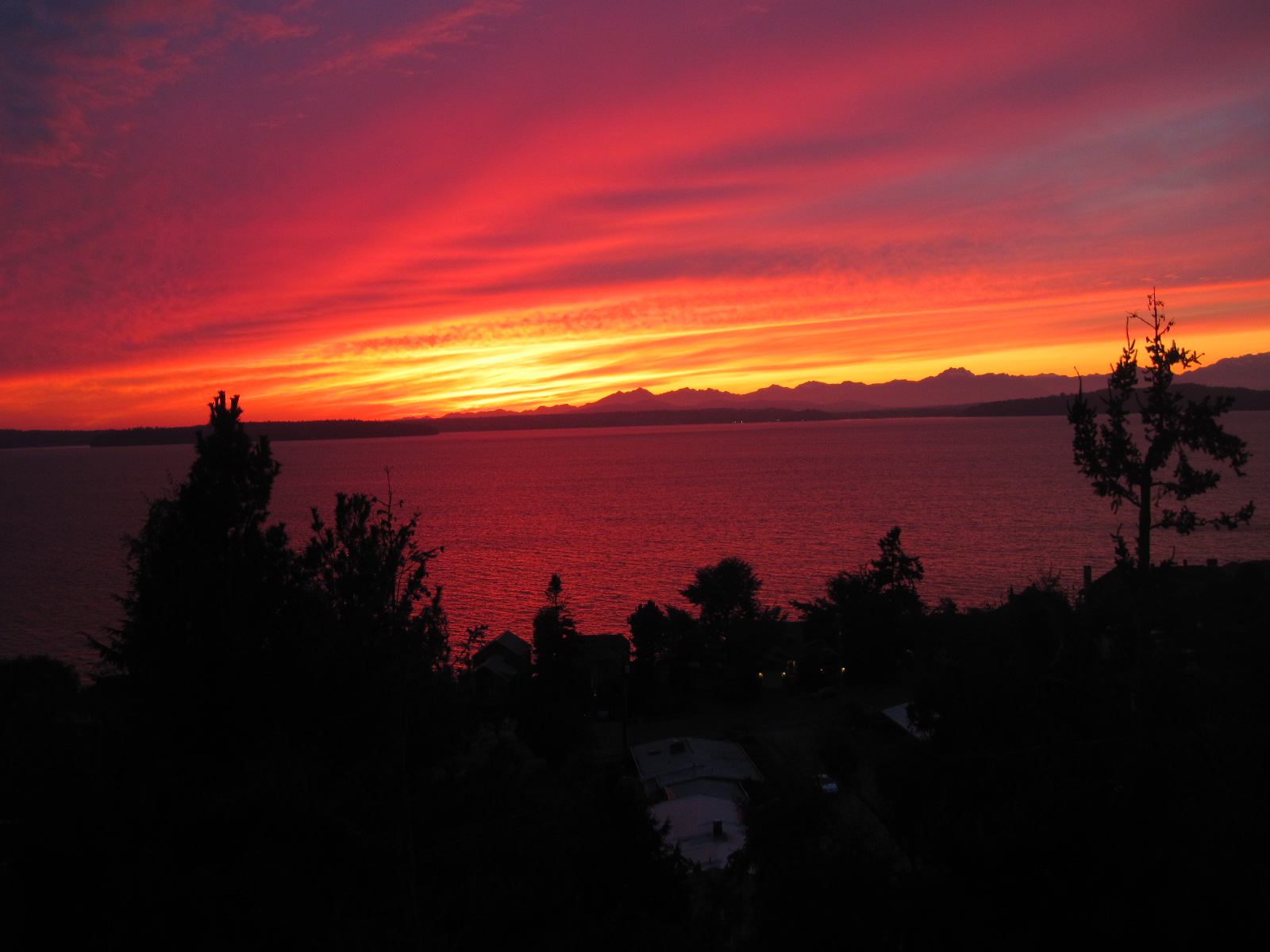
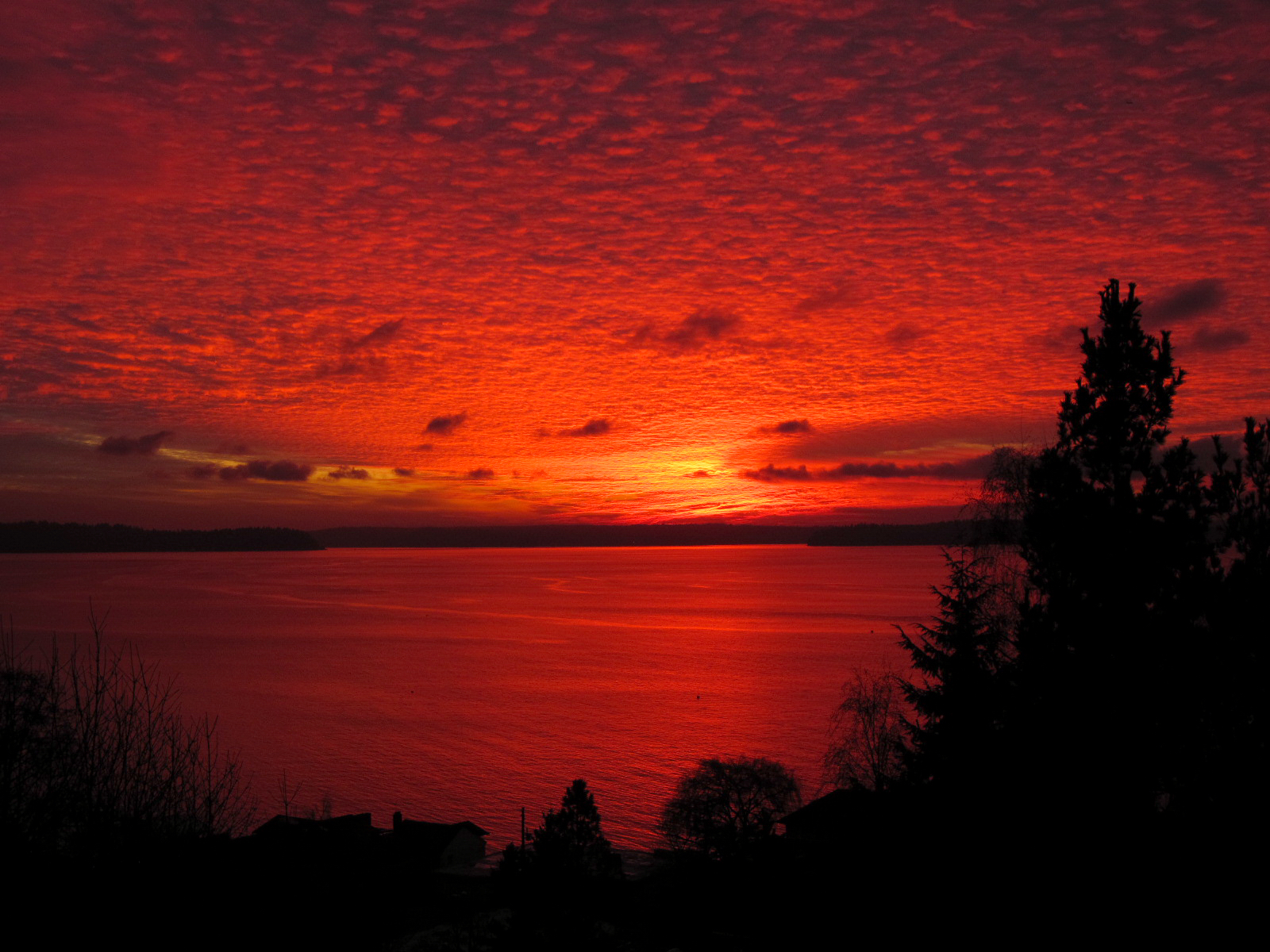
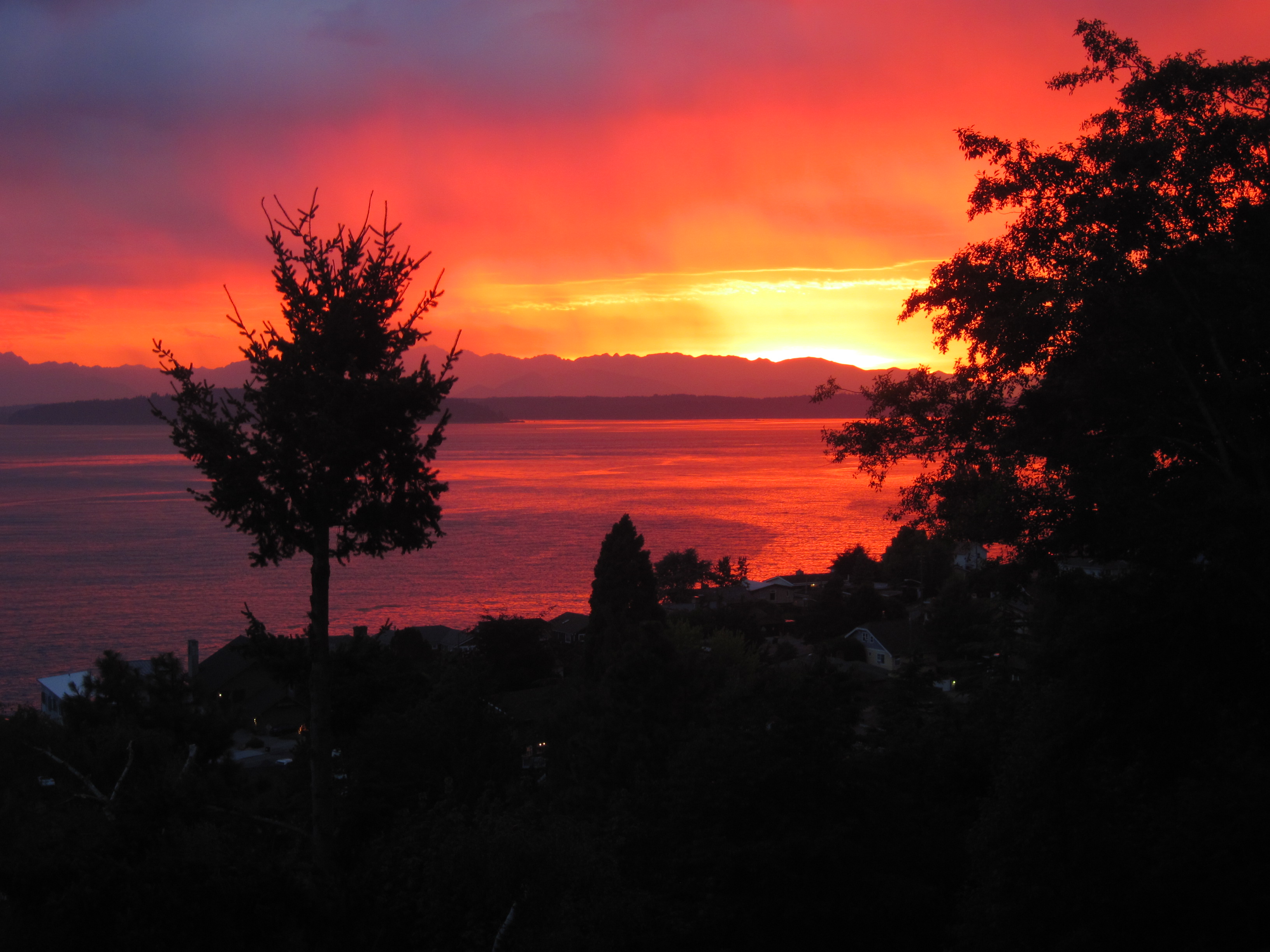
WOW! Those are award winning pictures pj, thanks for sharing!
You'll like this one.
The first 10 years or so after we got married, on weekends, I would sometimes look at unique weather conditions that would cause incredible sunsets.
The best ones, were often when a heavy deck of clouds was covering the sky but was just clearing on the western horizon. If this looked likely, I would track the edge of the clouds that day, then we would get into the car to drive to the best spot(if it was west) and drive thru it or to it.
What is cool about sunsets that you observe while traveling west is that they ALWAYS last longer because you are traveling in the direction that the earth rotates.
So the sunset at point A, where you started from could be numerous minutes earlier than it is at point B, farther west where you end up at.
Of course that cloud formation I mentioned is always best AFTER the sun has just set.
This is because it illuminates the base of the clouds across a massive portion of the sky after it has dipped below the horizon. The picture below illustrates this affect. Note in the far right hand corner, at the horizon, the sky has barely cleared. The sun has set based on surface observations..........but not at 10,000+ feet up in the sky.
Here is a shot Taken Saturday night west of Cape Girardeau.

Great shot Grant.
I was hoping that you would chime in.
Obviously no problems with haze or visibility out there like we had here even though the weather conditions were similar.
Maybe this is more of a local issue related to local emissions of pollutants........one of which is NOT CO2.
After living here for 38 years, I just got used to it. Regardless, the haze and poor visibility here in the Summer is the rule.
I saw you had air quality issues for many days. I am hoping top get a better shot this weekend, going to Cotter, AR. Pretty dark out there.